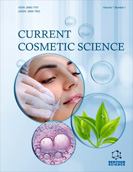Abstract
Background: 2-in-1 shampoos are very complex multi-component mixtures used for the cleansing of the hair fibers and the modulation of their tribological properties, contrib-uting to the reduction of the negative charge of damaged hair fibers. This is the result of the combined action of the polyelectrolytes and surfactants that play a central role in the effec-tiveness of modern 2-in-1 shampoo formulations. Thus, surfactants contribute to the removal of the dust and fatty compounds during the washing process, whereas polyelectrolytes present a strong ability to be deposited on the surface of damaged fibers, and enhance their tribologi-cal properties. However, the lack of knowledge about the main forces driving the conditioning process has pushed the research and development strategy of the cosmetic industry towards the design of state-of-the-art experimental and theoretical methodologies for evaluating the behavior of mixtures formed by polyelectrolytes and surfactants in solution and adsorbed onto solid surfaces with a negative charge and contact angle for water similar to those appearing in the surface of damaged hair fibers, which have become a very promising tool for obtaining important insights that can be exploited for the optimization of new formulations for hair cleaning and conditioning.
Aims: This work tries to provide an updated perspective of the current understanding of the behavior of mixtures containing polyelectrolytes and surfactants bearing opposite charges in relation to their performance in hair care and conditioning for providing a link between physi-co-chemical aspects and the performance of real 2-in-1 formulations.
Conclusion: The study of polyelectrolyte-surfactant mixtures is a powerful tools for obtaining useful information for the optimization of cosmetic formulations for hair care and condition-ing. However, the rational design of this type of cosmetic products must be considered a mul-ti-disciplinary challenge, which requires the combined efforts of researchers with very differ-ent backgrounds.
Keywords: Conditioning, shampoo, polyelectrolyte, surfactant, deposition, hair, formulation.
Graphical Abstract
[http://dx.doi.org/10.1007/978-1-4757-2009-9]
[http://dx.doi.org/10.3390/cosmetics3040034]
[http://dx.doi.org/10.1046/j.1467-2494.2000.00003.x] [PMID: 18503458]
[http://dx.doi.org/10.1016/j.cis.2021.102383] [PMID: 33690071]
[http://dx.doi.org/10.1046/j.1467-2494.2001.00057.x] [PMID: 18503439]
[http://dx.doi.org/10.4103/0974-7753.153450] [PMID: 25878443]
[http://dx.doi.org/10.3390/cosmetics8030071]
[http://dx.doi.org/10.1016/j.cis.2014.05.007] [PMID: 24954878]
[http://dx.doi.org/10.1016/j.cis.2010.01.007] [PMID: 20167304]
[http://dx.doi.org/10.1016/j.cis.2016.04.007] [PMID: 27337996]
[http://dx.doi.org/10.1021/la00015a029]
[http://dx.doi.org/10.1039/b917297a]
[PMID: 19450423]
[http://dx.doi.org/10.1016/j.polymer.2021.123442]
[http://dx.doi.org/10.1021/am900378b] [PMID: 20356112]
[PMID: 21635845]
[http://dx.doi.org/10.3390/cosmetics7020026]
[http://dx.doi.org/10.1002/9781119654926.ch13]
[http://dx.doi.org/10.1177/004051757704700906]
[http://dx.doi.org/10.1016/j.pmatsci.2008.01.001]
[http://dx.doi.org/10.1002/masy.19991450118]
[http://dx.doi.org/10.1002/masy.19981260120]
[http://dx.doi.org/10.1007/978-3-319-26414-1_8]
[http://dx.doi.org/10.1002/9781118683989]
[http://dx.doi.org/10.3390/colloids4030033]
[http://dx.doi.org/10.1016/j.colsurfb.2019.110578] [PMID: 31678812]
[http://dx.doi.org/10.1002/jsde.12415]
[http://dx.doi.org/10.1111/ics.12439] [PMID: 29095493]
[http://dx.doi.org/10.3390/cosmetics6010013]
[http://dx.doi.org/10.1039/C7CP05528E] [PMID: 29297520]
[http://dx.doi.org/10.1021/acs.jpcc.7b12457]
[http://dx.doi.org/10.3390/coatings9070438]
[http://dx.doi.org/10.1016/j.colsurfa.2019.124178]
[http://dx.doi.org/10.3390/polym12030624]
[http://dx.doi.org/10.3390/cosmetics1010003]
[http://dx.doi.org/10.3390/molecules24193442] [PMID: 31547491]
[http://dx.doi.org/10.3920/978-90-8686-728-8_22]
[http://dx.doi.org/10.1016/j.colsurfa.2010.12.012]
[http://dx.doi.org/10.1201/9780203907948]
[http://dx.doi.org/10.1021/jp8066553] [PMID: 19673140]
[http://dx.doi.org/10.1021/am200671m] [PMID: 21749104]
[http://dx.doi.org/10.1142/9789814313773_0004]
[http://dx.doi.org/10.3390/cosmetics8030077]
[http://dx.doi.org/10.3390/cosmetics8030077]
[http://dx.doi.org/10.1016/j.cis.2008.08.013] [PMID: 18929350]
[http://dx.doi.org/10.1039/b415140m] [PMID: 16862270]
[http://dx.doi.org/10.1016/j.cis.2014.10.005] [PMID: 25453660]
[http://dx.doi.org/10.1351/pac198456030343]
[http://dx.doi.org/10.1039/b901193e]
[http://dx.doi.org/10.1016/j.cocis.2020.04.002]
[http://dx.doi.org/10.1021/la950362y]
[http://dx.doi.org/10.1021/la9712911]
[http://dx.doi.org/10.1016/j.cis.2015.11.001] [PMID: 26608684]
[http://dx.doi.org/10.3390/polym11010051] [PMID: 30960035]
[http://dx.doi.org/10.1021/acs.langmuir.7b01288] [PMID: 28493707]
[http://dx.doi.org/10.1039/c3sm27698h]
[http://dx.doi.org/10.1016/j.cocom.2015.01.002]
[http://dx.doi.org/10.1021/ja408587u] [PMID: 24160889]
[http://dx.doi.org/10.1021/la500461y] [PMID: 25203784]
[http://dx.doi.org/10.1088/1742-6596/100/5/052034]
[http://dx.doi.org/10.1016/j.cis.2006.07.005] [PMID: 17011507]
[http://dx.doi.org/10.1016/0166-6622(86)80341-9]
[http://dx.doi.org/10.1021/la990865u]
[http://dx.doi.org/10.1021/am201740k] [PMID: 22301772]
[http://dx.doi.org/10.1021/la049922w] [PMID: 15274574]
[http://dx.doi.org/10.1021/am200350z] [PMID: 21667982]











